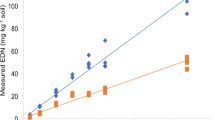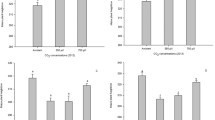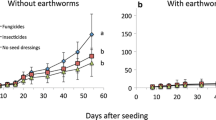Abstract
Toxins from Bacillus thuringiensis have beenused as pest management tools for more than 50 years. The effect of these toxins depends on the quantityof Bacillus thuringiensis (Bt) toxins ingestedby susceptible insects. Food ingestion is affected byCO2 concentration; plants grown in elevatedCO2 often have increased carbon/nitrogen ratios(C/N), resulting in greater leaf area consumption. Therefore, we hypothesized that elevated CO2would improve the efficacy of foliar applications ofB. thuringiensis. Cotton plants were grown ateither ambient (360–380 μl/l) or elevated CO2(900 μl/l). Groups of plants in both CO2treatments were exposed to low (30 mg/kg soil/week) orhigh (130 mg/kg soil/week) nitrogen (N) fertilizationlevels in a split plot design. The resulting plantswere assessed for N and carbon (C) contents. Leafdisks from the same plants were dipped in a Btsolution and then fed to Spodoptera exigua(Hübner), an insect species of considerableeconomic importance. Elevated CO2 significantlyreduced total N, and increased the C/N. Nitrogenfertilization significantly affected consumption byearly stadia larvae, larval weight gain, and relativegrowth rate (RGR). Interactions between CO2concentration and N fertilization level significantlyimpacted late stadia larval food consumption, andthrough differential Bt toxin intake, affectedduration of larval stage and mortality to the adultstage. We conclude that the elevated atmosphericCO2 concentrations expected in the next centurywill interact with commercial fertilization practicesto enhance the efficacy of B. thuringiensisformulations applied topically to crops. Theimplications for improved control are discussed.
Similar content being viewed by others
References
Acock, B., V.R. Reddy, H.F. Hodges, D.N. Baker and J.M. McKinion, 1985. Photosynthetic response of soybean Glycine max canopies to full-season carbon dioxide enrichment. Agronomy Journal 77(6): 942–947.
Arnone, J.A., III, J.G. Zaller, C. Ziegler, H. Zandt and C. Korner, 1995. Leaf quality and insect herbivory in model tropical plant communities after long-term exposure to elevated atmospheric CO-2. Oecologia 104(1): 72–78.
Arp, W.J. and B.G. Drake, 1991. Increased photosynthetic capacity of Scirpus olneyi after 4 years of exposure to elevated carbon dioxide. Plant Cell and Environ. 14(9): 1003–1006.
Bauer, L.S., 1995. Resistance: A threat to the insecticidal crystal proteins of Bacillus thuringiensis. Florida Entomol. 78(3): 414–443.
Bazzaz, F.A. and E.D. Fajer, 1992. Plant life in a carbon dioxide rich world. Sci.American 266(1): 68–74.
Becker, N. and M. Ludwig, 1993. Investigations on possible resistance in Aedes vexans field populations after a 10-year application of Bacillus thuringiensis-israelensis. J.of the American Mosquito Control Association 9(2): 221–224.
Bentz, J.A., J. Reeves, III, P. Barbosa and B. Francis, 1995. Within-plant variation in nitrogen and sugar content of poinsettia and its effects on the oviposition pattern, survival, and development of Bemisia argentifolii (Homoptera: Aleyrodidae). Environ.Entomol. 24(2): 271–277.
Berdegué, M., J.T. Trumble and W.J. Moar, 1996. Effect of CryIC toxin from Bacillus thuringiensis on larval feeding behavior of Spodoptera exigua. Entomol.Exp.Appl. 80(2): 389–401.
Biever, K.D., D.L. Hostetter and J.R. Kern, 1994. Evolution and implementation of a biological control-IPM system for crucifers: 24-year case history. Am.Entomol. 40(2): 103–108.
Castro, G., 1991. Global warming causes consequences and some implications for latin america. Interciencia 16(3): 119–124, 162.
Coviella, C.E. and J.T. Trumble, 1999. Effects of elevated atmospheric CO2 on insect-plant interactions. Conservation Biol. 13(8): 1–13.
Crawley, M.J., 1993. GLIM for Ecologists. Blackwell Scientific Publications, Oxford.
Diawara, M.M., J.T. Trumble, C.F. Quiros and J.G. Millar, 1992. Resistance to Spodoptera exigua in Apium prostratum. Entomol.Exp.Appl. 64: 125–133.
Diaz, S., L.H. Fraser, J.P. Grime and V. Falczuk, 1998. The impact of elevated CO2 on plantherbivore interactions: Experimental evidence of moderating effects at the community level. Oecologia 117(1–2): 177–186.
Duplessy, J.C., 1992. Paleoclimatological certainties. La Recherche 23(243): 558–562.
Environmental Protection Agency, 1999. The draft 1999 inventory of U.S. greenhouse emissions and sinks (1990–1997). Draft for public comment. Electronic source: http://www.epa.gov/globalwarming/inventory/199 9-inv.html, U.S.
Estiarte, M., J. Peñuelas, B.A, Kimball, D.L. Hendrix, P.J. Pinter, G.W. Wall, R.L. La Morte and D.J. Hunsaker, 1999. Free-air CO2 enrichment of wheat: leaf flavonoid concentration throughout the growth cycle. Physiol.Plantarum 105(3): 423–433.
Fajer, E.D., M.D. Bowers and F.A. Bazzaz, 1989. The effects of enriched carbon dioxide atmospheres on plant-insect herbivore interactions. Science 243(4895): 1198–1200.
Fajer, E.D., M.D. Bowers and F.A. Bazzaz, 1991. The effects of enriched carbon dioxide atmospheres on the buckeye butterfly J.coenia.Ecol. 72(2): 751–754.
Fan, S., M. Gloor, J. Mahlman, S. Pacala, J. Sarmiento, T. Takahashi and P. Tans, 1998. A large terrestrial carbon sink in North America implied by atmospheric and oceanic carbon dioxide data and models. Science 282(5388): 442–446.
Frankenhuyzen, K. van., 1993. The Challenge of Bacillus thuringiensis. In: P. Entwistle, J. Cory, M. Bailey and S. Higgs, (eds), Bacillus thuringiensis, an Environ.Biopesticide: Theory and Practice. John Wiley and Sons, New York. pp. 1–35.
Gharib, A.H. and J.A. Wyman, 1991. Food consumption and survival of Trichoplusia ni (Lepidoptera: Noctuidae) larvae following intoxication by Bacillus thuringiensis var. Kurstaki and Thuringhiensin. J.Econ.Entomol. 84(2): 436–439.
Georghiou, G.P. and M.C. Wirth, 1997. Influence of exposure to single versus multiple toxins of Bacillus thuringiensis subsp. israelensis on development of resistance in the mosquito Culex quinquefasciatus (Diptera: Culicidae). Appl.and Environ.Microbiology 63(3): 1095–1101.
Hails, R.S. and M.J. Crawley, 1992. Spatial density dependence in populations of a cynipid gall-former Andricus quercuscalicis. J.Animal Ecol. 61(3): 567–583.
Houghton, J.T. (ed.) 1996. Climate change 1995: the science of climate change. Cambridge University Press, Cambridge.
Huang, F., L.L. Buschman, R.A. Higgins and W.H. McGaughey, 1999. Inheritance of resistance to Bacillus thuringiensis toxin (Dipel ES) in the european corn borer. Science 284(5416): 965–967.
Joos, F., G.K. Plattner, T.F. Stocker, O. Marchal and A. Schmittner, 1999. Global warming and marine carbon cycle feedbacks an future atmospheric CO2. Science 284(5413): 464–467.
Karowe, D.N., D.H. Seimens and T. Mitchell-Olds, 1997. Species-specific response of glucosinolate content to elevated atmospheric CO-2. J.Chem.Ecol. 23(11): 2569–2582.
Kerslake, J.E., S.J. Woodin and S.E.Hartley, 1998. Effects of carbon dioxide and nitrogen enrichment on plant-insect interaction: The quality of Calluna vulgaris as a host for Operophtera brumata. New Phytol. 140(1): 43–53.
Koppenhofer, A.M. and H.K. Kaya, 1997. Additive and synergistic interaction between entomopathogenic nematodes and Bacillus thuringiensis for scarab grub control. Biol.Control 8(2): 131–137.
Lincoln, D.E., E.D. Fajer and R.H. Johnson, 1993. Plant-insect herbivore interactions in elevated carbon dioxide environments. Trends in Ecol.Evol. 8(2): 64–68.
Lindroth, R.L., K.K. Kinney and C.L. Platz, 1993. Responses of deciduous trees to elevated atmospheric carbon dioxide productivity phytochemistry and insect performance. Ecology 74(3): 763–777.
Mahlman, J.D., 1997. Anticipated climate changes in a high-CO2 world: Implications for long term planning, U.S. Global Change Research Program. Electronic source: http://www.usgcrp.gov/usgcrp/9799DD.html.
Marks, S. and D.E. Lincoln, 1996. Antiherbivore defense mutualism under elevated carbon dioxide levels: A fungal endophyte and grass. Environ.Entomol. 25(3): 618–623.
Minkenberg, O.P.J.M. and M.J.J. Fredrix, 1989. Preference and performance of an herbivorous fly, Liriomyza trifolii (Diptera: Agromyzidae), on tomato plants differing in leaf nitrogen. Annals of the Entomol.Soc.America 82(3): 350–354.
Minkenberg, O.P.J.M. and J.J.G.W. Ottenheim, 1990. Effect of leaf nitrogen content of tomato plants on preference and performance of a leafmining fly. Oecologia 83(3): 291–298.
Osbrink, W.L.A., J.T. Trumble and R.E. Wagner, 1987. Host suitability of Phaseolus lunata for Trichoplusia ni (Lepidoptera: Noctuidae) in controlled carbon dioxide atmospheres. Environ.Entomol. 16: 639–644.
Peñuelas, J., M. Estiarte, B.A. Kimball, S.B. Idso, P.J. Pinter Jr., G.W. Wall, R.L. Garcia, D.J. Hansaker, R.L. Lamorte and D.L. Hendrix, 1996. Varety of responses of plant phenolic concentration to CO-2 enrichment. J.Experimental Botany 47(302): 1463–1467.
Peñuelas, J., M. Estiarte and J. Llusia, 1997. Carbon-based secondary compounds at elevated CO-2. Photosynthetica 33(2): 313–316.
Polle, A., M. Eiblmeier, L. Sheppard and M. Murray, 1997. Responses of antioxidative enzymes to elevated CO-2 in leaves of beech (Fagus sylvatica L.) seedlings grown under a range of nutrient regimes. Plant Cell and Environ. 20(10): 1317–1321.
Raynaud, D., J. Jouzel, J.M. Barnola, J. Chappellaz, R.J. Delmas and C. Lorius, 1993. The ice record of greenhouse gases. Science 259(5097): 926–934.
Rogers, G.S., P.J. Milham, M.C. Thibaud and J.P. Conroy, 1996. Interactions between rising CO-2 concentration and nitrogen supply in cotton. I. Growth and leaf nitrogen concentration. Australian J.Plant Physiol. 23(2): 119–125.
Sarmiento, J.L., T.M.C. Hughes, R.J. Stouffer and S. Manabe, 1998. Simulated response of the ocean carbon cycle to anthropogenic climate waming. Nature 393(6682): 245–249.
Sarmiento, J.L. and C. Le Quere, 1996. "Oceanic carbon dioxide uptake in a model of centuryscale global warming. Science 274(5291): 1346–1350.
Schmidt, D.J. and J.C. Reese, 1986. Sources of error in nutritional index studies of insects on artificial diet. J.Insect Physiol. 32: 193–198.
Sowers, T., M. Bender, L. Labeyrie, D. Martinson, J. Jouzel, D. Raynaud, J.J. Pichon and Y.S. Korotkevich, 1993. A 135,000-year Vostok-specmap common temporal framework. Paleoceanography 8(6): 737–766.
Tabashnik, B.E., 1997. Seeking the root of insect resistance to transgenic plants. Proceedings of the National Academy of Sciences of the USA 94(8): 3488–3490.
Tabashnik, B.E., Y.-B. Liu, T. Malvar, D.G. Heckel, L. Masson and J. Ferre, 1998. Insect resistance to Bacillus thuringiensis: Uniform or diverse? Philosophical Transactions of the Royal Society of London B Biological Sciences 353(1376): 1751–1756.
Tabashnik, B.E., Y.B. Liu, N. Finson, L. Masson and D.G. Heckel, 1997a. One gene in diamondback moth confers resistance to four Bacillus thuringiensis toxins. Proceedings of the National Academy of Sciences of the USA 94(5): 1640–1644.
Tabashnik, B.E., Y.B. Liu, T. Malvar, D.G. Heckel, L. Masson, V. Ballester, F. Granero, J.L. Mensua and J. Ferre, 1997b. Global variation in the genetic and biochemical basis of diamondback moth resistance to Bacillus thuringiensis. Proceedings of the National Academy of Sciences of the USA 94(24): 12780–12785.
Tamez-Guerra, P., C. Garcia-Gutierrez, H. Medrano-Roldan, L.J. Galan-Wong and C.F. Sandoval-Coronado, 1999. Spray-dried microencapsulated Bacillus thuringiensis formulations for the control of Epilachna varivestis Mulsant. Southwestern Entomol. 24(1): 37–48.
Tate, D.F., 1994. Determination of nitrogen in fertilizer by combustion: Collaborative study. J.AOAC International 77(4): 829–839.
Traw, M.B., R.L. Lindroth and F.A. Bazzaz, 1996. Decline in gypsy moth (Lymantria dispar) performance in an elevated CO-2 atmosphere depends upon host plant species. Oecologia 108(1): 113–120.
Trumble, J.T., 1998. IPM: Overcoming conflicts in adoption. Integrated Pest Management Reviews 3: 195–207.
Waldbauer, G.P., 1968. The consumption and utilization of food by insects. Advances in Insect Physiology, 5: 229–288.
Wier, A.T. and D.J. Boethel, 1995. Feeding, growth, and survival of soybean looper (Lepidoptera: Noctuidae) in response to nitrogen fertilization of nonnodulating soybean. Environ.Entomol. 24(2): 326–331.
Wirth, M.C., A. Delecluse, B.A. Federici and W.E. Walton, 1998. Variable cross-resistance to Cry11B from Bacillus thuringiensis subsp. jegathesan in Culex quinquefasciatus (Diptera: Culicidae) resistant to single or multiple toxins of Bacillus thuringiensis subsp. israelensis. Appl.Environ.Microbiology 64(11): 4174–4179.
Wirth, M.C. and G.P. Georghiou, 1997. Cross-resistance among CryIV toxins of Bacillus thuringiensis subsp. israelensis in Culex quinquefasciatus (Diptera: Culicidae). J.Econ.Entomol. 90(6): 1471–1477.
Author information
Authors and Affiliations
Corresponding author
Rights and permissions
About this article
Cite this article
Coviella, C., Trumble, J. Effect of elevated atmospheric carbon dioxide on the use of foliar application of Bacillus thuringiensis. BioControl 45, 325–336 (2000). https://doi.org/10.1023/A:1009947319662
Issue Date:
DOI: https://doi.org/10.1023/A:1009947319662




